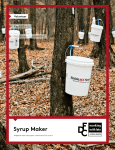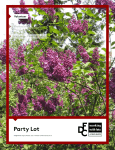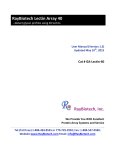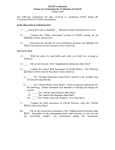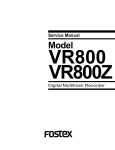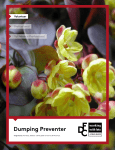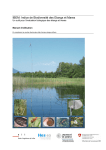Download Ring Around the Garden Lot Design
Transcript
Volunteer Professional Volunteer + Professional Ring Around the Garden Image Source: Sosanna., “Redbud_Bee.JPG” 30 March 2015 via Wikimedia CC BY-SA 4.0 Field Guide | DFC-lots.com | Ring Around the Garden 2 HELLO What is the lot design likely to cost? The estimated cost of the Ring Around the Garden is over $5,500 and based on volunteer and professional labor. The Field Guide recommends hiring a professional for the earthwork and lot preparation. Planting can be completed by a professional or by volunteers. The cost assumes that residents or volunteers have access to basic safety gear and garden tools. MY NAME IS Ring Around the Garden The Ring Around the Garden is a circular rain garden designed for a double lot. Due to its large size, the Ring Around the Garden is suitable for stormwater collection from large impervious areas, such as large parking lots, schools, churches and warehouses. The soil pile excavated from the rain garden creates a center mound to be planted with colorful spring blooms. The Field Guide encourages you to make this lot design your own by adding ornamental trees, sculptures, or other unique features on the mound. This design requires integration with municipal systems and is a great choice for those looking to play a role in green infrastructure! For more information refer to DFC-lots.com Cost $50 - 1,000 How much upkeep will this lot design require? This lot design requires a high level of maintenance to thrive. Maintenance will include weeding and watering the plants, trees, and large-scale rain garden, particularly during the first two years while the plants establish themselves. Will the installation of this lot design require a professional? The installation of this lot design will require professional assistance for the first few steps. The Field Guide identifies volunteer opportunities if you, with the help and support of friends, family, or neighbors, would like to construct the planting portion of this lot design. Please refer to the Step-By-Step section for guidance on the recommended professional and volunteer steps. If you do not feel able to tackle the volunteer aspect of this lot design, a professional can construct the entire project. How long will it take to install this lot design? This lot design requires a professional for several steps of the installation. The projected installation time listed below only accounts for the volunteer opportunities listed in the Step-By-Step section. While people tackle projects differently, the Field Guide estimates the installation time of the lot design to be one weekend with a volunteer group organized by a knowledgeable lot leader. The Field Guide recommends the help of at least eight healthy adults or youth to construct this lot design. The Field Guide assumes that the lot is ‘construction ready,’ and all equipment and materials required for lot design have been acquired and are ready to use. $1,000 - 2,500 $2,500 - 5,500 $5,500 + People Volunteer Professional Volunteer + Professional Experience Beginner Intermediate Advanced Low Medium High Good Better Best Upkeep Stormwater Location Double Lot in Full Sun or Part Sun (Near School or Community Hub is Ideal) Field Guide | DFC-lots.com | Ring Around the Garden 3 Ring Around the Garden Examples 1 - NORA Project 2 - Crocuses around Tree Section Grass Area Wetland Seed Mix Grass Mound Wetland Seed Mix Grass Area Where Do I Grow? The Ring Around the Garden is best suited for double lots or corner lots. Its most effective use would be to collect stormwater from at least one large-scale commercial or institutional parking lot or roof. 0.0’ -1.0’ -1.0 ’ 0.0 ’ +1.0’ Section Rain Garden Seed Mix Tree Planted Mound Grass or Groundcover Benches (Optional) Image Source: 1) Lambert, Rotherstien & Associates. NORA1, Owned by DFC; 2) Davida3, “crocuses.” 26 Febuary 2011 via Flickr, CC BY-ND 2.0 Field Guide | DFC-lots.com | Ring Around the Garden 4 Before You Start ‘Construction Ready’ This lot design assumes that you have prepared the lot to a ‘construction ready’ state. ‘Construction Ready’ refers to a lot that is clean and clear of trash, hazardous objects, unwanted trees, brush and vegetation, fences, and other unwanted structures. It may be necessary to remove grass in preparation for your lot design. Refer to the Remove Your Grass box located on the right hand side of this page for more information. Is there an available water source near your lot? Consider how and where you will access water during and after construction to ensure that your plants can establish. If your lot is not ready for construction, refer to the Clean + Green lot design. You can find the lot design at DFC-lots.com. Call Before You Dig Locate underground utilities before beginning your lot design. MISS DIG provides a free service to Michigan residents by locating and marking utilities on requested properties. Call (800) 482-7171 or 811 at least three days before you plan to start digging on your lot. Test Your Soil Harmful pollutants have made their way into many urban soils. To proceed with awareness, consider having your soil tested before construction. Two great options are available: ·· Soil testing is free to members of Keep Growing Detroit’s Garden Resource Program. Call (313) 757 – 2635 for more information or visit detroitagriculture.net. ·· If you are not yet a member, you can work directly with Michigan State University’s (MSU) Extension Program. They have a Home Lawn and Garden Soil Test Mailer for $25. For more information call (888) 678 – 3464 or visit msusoiltest.com. ·· If you are concerned about the presence of lead or other contaminants in your soil, call the Michigan Department of Health and Human Services at (866) 691 – 5323 or (800) 424 – LEAD. Remove Your Grass Need to remove grass in areas where you are constructing your lot design? There are many ways to remove unwanted grass. The first is to remove the grass and its root system by digging up the grass. Another option is to cover your lot with cardboard or a plastic tarp to smother your grass in darkness. It will take several weeks, but after being covered, the dead grass will be easier to remove. Till Safely Before you till, inspect your lot for signs of buried concrete or rubble that was not removed during the cleanup stage. Large debris can ruin tiller blades. When tilling, wear appropriate safety gear, such as covered boots with socks, long pants, safety glasses, dust mask, and ear protection. Make sure you understand the safe operating procedures of your tiller. Refer to the user’s manual. Field Guide | DFC-lots.com | Ring Around the Garden 5 What You Need: Shopping List Shopping List The shopping list provides a breakdown of potential materials, tools, and resources required to construct this lot design. This shopping list is designed for a double lot (60 by 100 feet). Materials MaterialsList List Materials ·· Mulch or Wood Chips, 0.5 cubic yards ·· Rain Garden Planting Soil, 46 cubic yards (50% sand, 25% topsoil, and 25% compost or leaf litter) ·· Downspout Disconnect: Standpipe cap, downspout elbow, downspout connection pipe, rubber cap and hose clamp Planting Tools + Resources Suggested Tools ·· Marking Paint and Tape Measure ·· Safety Gear: Gloves, heavy work boots, tall socks, pants, long sleeve shirts, dust masks, protective eye wear, ear plugs, and hard hats (if using heavy machinery) ·· Garden Tools: Spades, shovels, rakes, trash bags, and wheelbarrows ·· Hacksaw and Screwdriver ·· Earth Moving Machinery: Skid loader or backhoe ·· Autumn Brilliance Serviceberry, 2 pots or Balled and Burlapped ·· Eastern Redbud, 1 pot or Balled and Burlapped ·· American Sycamore, 2 pot or Balled and Burlapped ·· Mixed Daffodils, 100 bulbs ·· Mixed Crocuses, 150 bulbs ·· Autumn Crocuses, 150 bulbs ·· Snowdrops, 200 bulbs ·· Periwinkle, 100 pots or plugs ·· Giant Onion, 100 bulbs ·· Mixed Lenten Roses, 100 bulbs ·· Ball Cart, for moving heavy trees Rain Garden Seed Mix Potential Water Sources ·· Rain Garden Seed Mix, 0.5 pound of seed ·· Garden Hose with potential extension hose ·· Annual Cover Crop, 1 pound of seed ·· Sprinkler ·· Germination Blanket, 2 rolls (6.5 by 112.5 feet) ·· Rain Barrel in addition to other water source ·· Downspout Disconnect (shown in lot design) Field Guide Resources Resources are available on the Field Guide’s website. ·· Clean + Green ·· Tree Planting Detail ·· Bulb Planting Detail Remaining Lot (Optional) Groundcover ·· Low-Maintenance Fescue Mix, 26 pounds of seed ·· Germination Blanket, 6 rolls (8 by 112.5 feet) Field Guide | DFC-lots.com | Ring Around the Garden 6 Ring Around the Garden Step-By-Step Let’s Start Want to create the Ring Around the Garden? The Field Guide recommends hiring a professional for all tasks. Here are a few guiding principles to help you understand the tasks involved in the lot design. Only undertake installing the design yourself if you have professional construction experience. Check off tasks as you go along. Lot Design Steps Professional: Prepare Your Lot Excavate + Sculpt Soil Volunteer Opportunities: Plant Trees Sow Rain Garden Disconnect Your Downspout Maintain Your Lot Sow Remaining Lot Make a Circle Place a stake at the desired location for the center of circle. Tie a string 10 feet long to the stake. Walk in a circle using the string to create an even-radius circle in the landscape. As you walk in the circle, mark your path on the ground. You can use these markings to help locate the edge of your rain garden. Prepare Your Lot The Ring Around the Garden is one of the more complex lot designs in the Field Guide. It is recommended that you hire a professional for these steps: Prepare Your Lot and Excavate + Sculpt Soil. If you decide to complete this lot design without the recommended assistance of a professional, the guiding principles below are provided to help assist you with the installation of the lot design. ·· This lot design utilizes a double lot, typically 60 by 100 feet. ·· The Ring Around the Garden should be constructed as shown in the lot design plan on page 10 to ensure the rain garden and mound are the correct depth and height. ·· The Ring Around the Garden should be a minimum of 10 feet from any adjacent building and at least five feet from sidewalks and property lines. ·· For the rain garden to work, water must be directed into it. The Field Guide recommends constructing your rain garden near a downspout from the roof of a large building, such as a school, church, or museum, or near hard surfaces like a parking lot. Ensure water flows from these surfaces into your rain garden circle. ·· Your rain garden should be one square foot for every ten square feet of hardscape or stormwater area directed into your rain garden. The Field Guide recommends your rain garden circle be a total of approximately 830 square feet. ·· The Ring Around the Garden is designed to accommodate or collect stormwater runoff from up to 8,300 square feet of roof or hard surfaces. Field Guide | DFC-lots.com | Ring Around the Garden 7 Ring Around the Garden Step-By-Step ·· If the stormwater collection area is larger than 8,300 square feet, you will either need to adjust rain garden to accommodate a larger stormwater capacity or install an overflow culvert, which will require permitting and integration into the municipal infrastructure. ·· The Ring Around the Garden shown on the design plan is 50 feet in diameter, measuring from the outer edges of the stormwater circle. ·· Once you decide on a location for your rain garden and mounds, use marking paint and a tape measure to map out the size, shape, and dimensions of your design. Need help creating a circle? Refer to Make a Circle on page 6. ·· You do not need to kill grass in the lot you wish to construct the Ring Around the Garden as tilling and earth moving will naturally help with grass removal. Excavate + Sculpt Soil The Field Guide recommends hiring a professional for completing the earthwork portion of the lot design. Alternatively, the rain garden can be dug and sculpted by hand but will require a large group of volunteers. ·· Dig the rain garden approximately 2.5 feet deep. The mound is created from soil excavated from the rain garden, avoiding the need to haul soil off site. ·· After removing soil, check that the bottom of the rain garden is level. An easy way to check this is with a string level or a spirit level attached to a two-by-four board. A level bottom is important to maximize infiltration and minimize the chance of standing water in the rain garden. ·· After leveling the bottom, the soil should be prepared by scarifying, raking, or tilling the soil four to six inches deep to loosen any compaction. ·· Fill the rain garden with 18 inches (46 cubic yards) of rain garden planting soil to create a one foot depression. ·· Rain garden planting soil should consist of approximately 50% sand, 25% topsoil, and 25% compost or leaf litter. ·· Mix together and place in rain garden. Rain garden edges should slope at 33% (1 unit of rise for 3 units of run). ·· Ensure water does not flow onto adjacent properties. Plant Trees The Field Guide recommends planting 1.5 inch diameter trees; however, smaller or larger trees can be planted if preferred. Trees and large shrubs can be purchased in pots or balled and burlapped. If you decide to plant larger trees, the Field Guide recommends speaking with a professional or an educational group as older trees can be more difficult to establish. Plant trees as soon as possible after purchasing. If you cannot plant them the same day, do not leave unplanted trees in direct sunlight. Keep them in shade and well watered until you can plant them. (Trees dry out fast!) Identify the location where you wish to plant the trees. Dig a hole three times the width of the root ball and equal to the depth. Pots should be removed before placing the tree in the planting hole. Balled and burlapped root balls should remain wrapped until placed in hole. Unwrap the top 1/3 of the root ball and peel back the burlap once planted. Remove any twine, nails, or stakes. The root flare should be level with the ground when you place the tree in the hole. Water the root ball, then backfill the hole with the soil previously removed from planting. Add water to the tree every six inches as you backfill the hole. Compact the soil lightly after each watering until the hole is filled with soil and level with the adjacent ground. Field Guide | DFC-lots.com | Ring Around the Garden 8 Ring Around the Garden Step-By-Step The Field Guide recommends three foot diameter by three inch depth of wood chips or mulch around trees. 0.5 cubic yards of mulch is recommended for five trees. Keep mulch a few inches away from tree trunks. For more guidance on tree planting, refer to the Tree Planting Detail. Sow Rain Garden Soil should be prepared for seeding by scarifying, raking, or tilling the soil four to six inches deep to loosen any compaction, allowing for easier seed germination and better water infiltration. Tilling should not be done without an assessment of buried cement, debris, or large rocks. Be sure to select the correct size of machinery for the job. Seeding should take place in either spring (midMay to mid-June) or fall (mid October to end of November). Ernst Conservation Seed’s Rain Garden Mix and Annual Cover Crop seed mix are good options for the Ring Around the Garden; similar mixes are available from other suppliers. Ernst Conservation Seed’s Mix suggests 0.5 pounds of Rain Garden Mix with 0.7 pounds of Annual Cover Crop seed mix per 1,000 square feet. The Field Guide recommends 0.5 pounds of Rain Garden Mix and one pound of Annual Cover Crop seed mix for the rain garden circle (830 square feet). Once seeds have been mixed, spread seed evenly across the rain garden circle. You can do this by hand or with a hand-cranked whirlwind seeder. You may need to do this several times to get even coverage. Gently water seedlings daily until they are four to six inches in height. Placing a thin layer of straw or a germination blanket over seeded areas will help ensure that your seed establishes by keeping seeds from blowing away and protecting them from birds. Two 6.5 by 112.5 foot single net germination blankets will cover meadow area. Germination blankets or straw can be purchased at most nurseries and garden stores, including Detroit Farm and Garden. Disconnect Your Downspout One of the easiest ways to collect stormwater is by disconnecting your downspout and directing it into your rain garden. Before you start, remember that disconnected downspouts should extend at least six feet from any house foundation and five feet from adjacent property or public sidewalk. Avoid disconnecting downspouts where they might discharge water across walkways, patios, or driveways or where they might be a tripping hazard. Do not disconnect directly over a septic system. Follow these steps to help you redirect your roof water into your rain garden. ·· Measure the existing downspout, and mark it approximately nine inches above sewer connection or standpipe. ·· Cut with a hacksaw and remove cut piece. ·· Plug or cap the sewer standpipe with a rubber cap secured by a hose clamp. Use screwdriver to tighten and secure cap. ·· Attach elbow joint over the downspout. ·· Add downspout extension to elbow joint. Extension should be length needed to carry water away from house and towards rain garden. ·· Secure pieces with sheet metal screws at each joint. ·· Use plastic or concrete splashblocks, rocks, flagstone, or boulders at the end of the downspout to control erosion of soil and plants in the rain garden from stormwater. For more information, refer to DWSD’s How to Disconnect a Downspout document. Field Guide | DFC-lots.com | Ring Around the Garden 9 Ring Around the Garden Step-By-Step Maintain Your Lot Design Sow Remaining Lot A rain garden requires care and maintenance to thrive. Rain Garden: Rain gardens will require weeding, watering, and mowing. In the first year, cut back to four to six inches whenever plants reach above ten inches in height. After the first year, continue weeding and mowing your rain garden in late fall or early spring to keep the rain garden at its best. It will take about three years for the rain garden to establish. Rain gardens are a work in progress. If you feel yours needs more color, it is okay to add additional native seeds and seed mixes. Annual Cover Crop is used to establish the Rain Garden Seed Mix and does not require annual re-seeding. If you are seeking a lower maintenance alternative to a traditional lawn, the Field Guide recommends a fescue seed mix. If you follow the Ring Around the Garden lot design you will need approximately 26 pounds of fescue seed mix for the remaining lot and six 8 by 112.5 foot rolls of single net germination blankets. This family of floppy grasses is drought-resistant and requires one cutting (in August or September) per year. Fescue can be established in full sun to shade and should be seeded in spring (mid-March to mid-May) or fall (August to September). Soil should be prepared for seeding by scarifying, raking, or tilling the soil four to six inches deep to loosen any compaction, allowing for easier seed germination and better water infiltration. Apply seed mix to a damp lot. Sow seed across the remaining lot by using a seed spreader or by hand. A seed rate of five pounds per 1,000 square feet is recommended. Gently water seedlings daily until they are four to six inches in height. Placing a thin layer of straw or a germination blanket over seeded areas will help ensure that your seed establishes by keeping seeds from blowing away and protecting them from birds. Germination blankets or straw can be purchased at most nurseries and garden stores. Visit the Resources page on the Field Guide’s web site (DFC-lots.com) to discover other vendors and places to purchase plants. Once established, grass will not require supplemental watering except during unusually dry periods. Eco-Turf Low Maintenance Fescue Mix is one recommended seed mix and can be purchased through the Michigan Wildflower Farm. Average Height of Plants 20’ 15’ 10’ 5’ Other Field Guide lot designs can be used as groundcovers. Check out the web site for additional options and ideas. Next Level: If you would like to bring additional color to your grass, you can plant bluebells, crocuses and/or daffodils to create a decorative show in spring. Bulbs should be planted in the fall. 2.5’ Trees, Grasses, and Perennials For more guidance on bulb planting refer to the Bulb Planting Detail. Field Guide | DFC-lots.com | Ring Around the Garden 10 Ring Around the Garden Lot Design Alley 30’-0” Property Line Property Line Refer to the Construction Package for more details - located at DFC-lots.com. 30’-0” Strengthen your neighborhood’s identity! Align your planting beds with the front setback line of adjacent buildings. Individual Ornamental Tree Individual Shade Tree 3 0.0’ -1.0 ’ -1.0’ 0.0 ’ Commercial or Institutional Building +1.0’ 2 1 30’-0” Property Line Property Line 5 30’-0” 4 6 Setback Line Downspout Disconnect Alley 7 Sidewalk 3 0.0’ Road -1.0’ 1 Shade Tree (Sycamore) 3 Ornamental Tree +1.0’ (Serviceberry) 2 Ornamental Tree (Redbud) 4 Rain Garden 1 Seed Mix -1.0 0’ ’ 0.0 ’ 5 2 6 Planted Mound (Bulbs and Groundcover) Bench (Optional) 4’ 8’ 16’ Grass or Optional 7 Commercial Groundcover or Institutional Building Field Guide | DFC-lots.com | Ring Around the Garden 11 Planting: Full Sun to Part Sun 3 Autumn Brilliance Serviceberry1 Amelanchier x grandiflora 25’ Height x 15’ Width. Blooms April. Quantity: 2 Alley pots or B & B Eastern Redbud Tree2 Cercis canadensis 15’ Height x 20’ Width. Quantity: 1 pot or B & B 2 1 5 Property Line Property Line 30’-0” Com or Ins Bu 30’-0” Key American Sycamore3 Platanus occidentalis 60’ Height x 50’ Width. Quantity: 2 pots or B & B Setback Line Mixed Daffodils4 Narcissus 18” Height x 24” Width Blooms in spring Sidewalk Quantity: 100 bulbs Road 3 1 American Sycamore 2 Eastern Redbud Tree 3 Serviceberry Tree 4 6 7 0.0’ 4 -1.0 Rain Garden Mix ’ 0.0 Mixed Crocuses Crocuses 4” Height x 4” Width Blooms in spring Quantity: 150 bulbs 5 Autumn Crocuses Colchicum cilicicum 4” Height x 4” Width Blooms September - October Quantity: 150 bulbs +1.0’ 6 1 5 ’ Bulbs + Groundcover (Mixed Daffodils, Mixed Crocuses, Commercial Autumn Crocuses, Snowdrops, or Institutional Periwinkle, Giant Onion, and Building 2 Mixed Lenten Roses) 5 Snowdrops7 Galanthus nivalis 4” Height x 4” Width Blooms in March - April Quantity: 200 bulbs Periwinkle8 Vinca minor 4” Height x 24” Width Blooms May - July Quantity: 100 pots Setback Line 4 Downspout Disconnect -1.0’ Giant Onion9 6 Allium giganteum 12” Height x 12” Width Blooms in Summer Quantity: 100 bulbs 7 Image Source: 1) Paul Woods, “Amelanchier in bloom 1.” 13 April 2013 via Flickr, CC BY-NC-SA 2.0; 2) BETTY., “American_Eastern_Redbud_Tree” 8 April 2007 via Wikimedia, CC BY 2.0; 3) Georges Jansoone JoJan, “Plantanus Orientalis.” 22 April 2007 via Wikimedia, Public Domain. 4) Plashing Vole, “Mixed daffodils 2.” 8 April 2011 via Flickr, CC BY-NC-SA 2.0; 5) Rachelgreenbelt, “jdy072 bpl Crocus Mixed epl Blo.” 13 March 2011 via Flickr, CC BY-NC-SA 2.0; 6) Carol, “The autumn crocus IMG_5061.” 15 September 2014 via Flickr CC BY-NC-SA 2.0; 7) Gideon Chilton, “Snowdrops – Little Oakley.” 16 February 2014 via Flickr, CC BY-NC 2.0; 8) H. Zell, “Vinca minor, Apocynaceae, Lesser Periwinkle, habitus; Karlsruhe, Germany.” 14 April 2009 via Wikimedia CC BY-SA 3.0 9) Stefan 1080, “Allium.” 26 May 2014 via Flickr CC BY-NC-SA 2.0 10) Filip Vervisch, “Helleborus-zaterdag 28 februari 2009 173107.” 28 February 2009 via Flickr, CC BY-NC-SA 2.0 Sidewalk Mixed Lenten Roses10 Helleborus ‘Red Lady’, ‘walhelivor’, ‘Pink Lady’, and Helleborus niger ‘Jacob’ Varies: Approximately 12” Height x 18” Width Blooms Early Spring Quantity: 100 bulbs Field Guide | DFC-lots.com | Ring Around the Garden 12 Planting: Full Sun to Part Sun Rain Garden Mix New England Aster, Aster novae-angliae (1% of mix) Mixing 0.5 pounds of Rain Garden Mix with one pound of Annual Cover Crop seed mix is recommended for this lot design. Swamp Milkweed, Asclepias incarnata (1% of mix) You can buy these seeds premixed at Ernst Conservation Seeds. River Oats, Chasmanthium latifolium (38% of mix) Virginia Wildrye, Elymus virginicus (20% of mix) Fox Sedge, Carex vulpinoidea (10% of mix) Purple Coneflower, Echinacea purpurea (4% of mix) Tall White Beardtongue, Penstemon digitalis (3% of mix) Blackeyed Susan, Rudbeckia hirta (3% of mix) Lanceleaf Coreopsis, Coreopsis lanceolata (3% of mix) Ohio Spiderwort, Tradescantia ohiensis (2% of mix) Oxeye Sunflower, Heliopsis helianthoides (2% of mix) Autumn Bentgrass, Agrostis perennans (2% of mix) Partridge Pea, Chamaecrista fasciculata (2% of mix) Marsh Blazing Star, Liatris spicata (2% of mix) Smooth Blue Aster, Aster laevis (1.5% of mix) Wild Senna, Senna hebecarpa (1% of mix) Path Rush, Juncus tenuis (1% of mix) Soft Rush, Juncus effusus (1% of mix) Wild Bergamot, Monarda fistulosa (0.8% of mix) Mistflower, Eupatorium coelestinum (0.5% of mix) Blue False Indigo, Baptisia australis (0.5% of mix) Early Goldenrod, Solidago juncea (0.5% of mix) Slender Mountainmint, Pycnanthemum tenuifolium (0.2% of mix) Plant Sizes Pots: 1.5 inch diameter trees are available at commercial landscape supply stores in pots or balled and burlapped (B & B). Groundcovers can be purchased in one to five gallon pots. The size of pots can change based on availability. Bulbs: Bulbs are cheaper if purchased in bulk. You can find bulk bags at garden stores. Seeds: Rain Garden Mix can be purchased in seed form. Field Guide | DFC-lots.com | Ring Around the Garden 13 Did You Know? Professionals Can Help! The Field Guide to Working With Lots provides a Construction Package for each lot design. The Construction Package includes information and details required for a professional to construct this design. On the Field Guide web site, use the Construction Package link located near the top of this lot design page to download and print. Your selected professional will then be able to provide a cost estimate and schedule based on the condition of your lot and the design you select. Want to Hire Locally? DFC-lots.com has a growing list of Detroit-based professionals and suppliers of landscape materials and services. Still unsure of where to start? Call (313) 294-LOTS or email fieldguide@detroitfuturecity. com for assistance. Helpful Facts ·· Rain gardens capture, hold, and release stormwater gradually back into the soil. ·· This rain garden is designed to provide habitat and food for a variety of birds and pollinators. ·· Looking for more information on rain gardens? The Sierra Club of Detroit has been running a rain garden program since 2012 and is happy to help. ·· The plants recommended for this lot design have been selected for their beauty, habitat creation, and local availability. Planting Tips ·· Call ahead to be sure the nursery or garden store has the plants you need for your lot design. ·· To save money, ask a friend or family member if they have any plants or cuttings they are willing to donate to your rain garden. ·· Inspect trees before purchasing, to make sure they are healthy and are well formed. This will help you select trees that are likely to survive. ·· The best time to plant is in spring or fall. ·· Do not plant in extreme heat. ·· Water after planting and as needed. ·· If mulching around trees, do not place mulch too close (less than three inches) to tree trunk. This will help keep the tree free of disease. Field Guide | DFC-lots.com | Ring Around the Garden Draw Your Lot 14 Field Guide | DFC-lots.com | Ring Around the Garden Ring Around the Garden Field Notes 15 Field Guide | DFC-lots.com | Ring Around the Garden 16 Visit DFC-lots.com #DFClots Image Source: Jeff Hart., “Platanus_occidentalis_Bloomington.jpg” 10 January 2010 via Wikimedia, CC BY 2.0
















